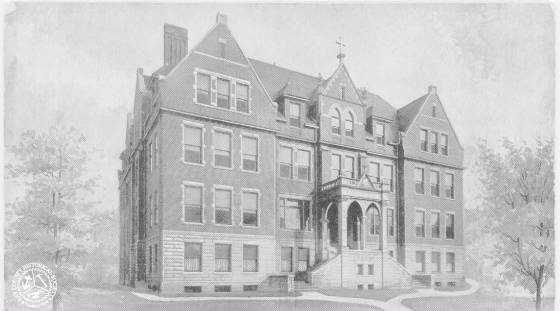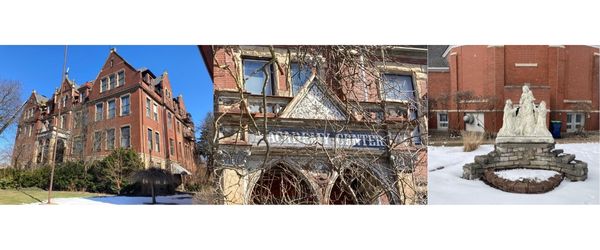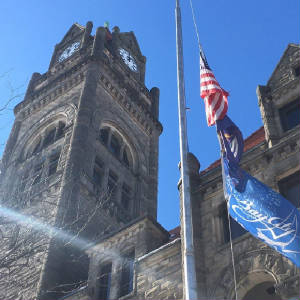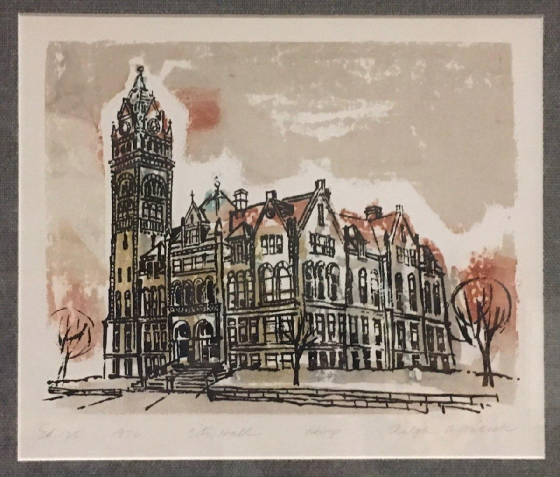By Sam Fitzpatrick

Image
Source: Bay County Historical Society
Holy Rosary Academy located at 512 N. Lincoln Ave, was a Catholic Preparatory School.
The original building was constructed 1896 and located in Essexville on the south side of Hudson Street,
west of the former St. John’s School. Today, this is where St. Jude Thaddeus Church stands.
The Academy is Destroyed by Fire
Administered by the Dominican Sisters of Marywood
Motherhouse out of Grand Rapids, the Academy remained in this location until 1904, when it suffered a catastrophic fire.
The cause was believed to be the product of arsonists.The fire occurred around midnight during the evening of March 8, 1904.
The three-story frame building was just shy of a decade old. The house infirmarian, Sister Chrysostoma, found the fire and
rang the alarm to wake the building’s occupants. Sister Alexia Flynn slept through the alarm, awoke to find herself
trapped and jumped from her window, resulting in her breaking her low jaw and leg. She was rushed to Mercy Hospital where
she passed away several days later. Originally, the sisters intended to rebuild in Essexville but decided
to relocate to central Bay City. One reason was that Essexville had a history of fires leading up to the
Academy burning, but the Essexville Council voted down a waterworks system. The Academy chose 512 Lincoln
Ave. right beside St. Boniface Church and rectory as its new home.
The New Academy
The structure was built and designed by a local architecture firm Pratt & Koeppe. They
also designed and constructed Elm Lawn Cemetery, the Historic Masonic Temple, and First Presbyterian Church. Holy
Rosary Academy was built using stone, pressed brick, and galvanized iron. It had cost around $40,000, or
$1.2 million today. Construction started on the building in 1904 and was opened for classes on October
2, 1905.
At the time of opening, the first floor contained
a kitchen, dining halls, sitting rooms for the sisters, and two recitation rooms. The second floor was
used as the main floor and included a library, chapel, music rooms, guest chambers, reception rooms, and recitation rooms.
The third floor consisted mainly of classrooms. The fourth floor was used for dormitories
with bathrooms, toilets, and more recitation rooms. The basement had a gym, a playroom for younger students,
laundry, and drying and ironing apparatuses. The building was also said to be full of lavish woodwork and
built-in cabinets. The building accommodated 80 pupils in its dormitories and had additional day students.
Academy’s Years of Operation
On June 14, 1906, the Academy was re-dedicated
by Most Reverend Henry Joseph Richter on the Feast of Corpus Christi. Priests from around the region attended,
along with a 400-member procession, which included the academy’s forty pupils. The dedication included
blessings, a Gregorian Mass, and other ceremonial events.
Father
Wyss, of nearby St. Boniface, served as a temporary chaplain. He had aided in finding a new location after
the 1904 fire in Essexville. The building only had resident chaplains on and off.
The school was an all-girls boarding school for 1st through 12th
grades until 1924. It had a focus on language, music, art, and elocution. The last class
of all-girls graduated from the academy on June 21, 1924, and consisted of seven pupils. During the graduation
ceremony, the graduates were followed from the rear of the building to their place on stage by a procession of 30 in the academy
chorus. The girls wore caps and gowns and held an arm bouquet of sweet peas, the class flower.
That same year, after a suggestion made by the Bishop Rev. Grand
Rapids, Edward Kelly, it became a residential school for boys and a day school for both boys and girls. In
September 1954, a kindergarten class opened. The boarding school closed in 1959, but the Academy continued
as a coeducational elementary school. In 1974, it became a Montessori program for 3–5-year-olds.

Image Source: Sam Fitzpatrick
Golden Jubilee
In 1954, the academy turned 50 years old and held a Golden Jubilee celebration on October
7th and 10th. It featured many clergy members from across Michigan. The October 7th
celebrations consisted of a Pontifical Low Mass, a dinner in the dining hall for diocesan clergy members, and a Solemn Benediction
of the Most Blessed Sacrament in the academy chapel. The October 10th ceremonies included a homecoming
celebration consisting of a Mass of Thanksgiving, a Solemn Benediction, and other festivities.
On October 2nd, 1955, during the afternoon services, the rosary shrine was dedicated
with the Most Rev. Stephen S. Woznicki, Bishop of Saginaw, officiating. The homecoming event was held with
tea served in the academy lounge by the Third Order of St. Dominic. The outdoor dedicatory rites concluded
the Golden Jubilee. The shrine was a three-figure rosary group statue composed of white Bianco marble set
on a French stone base. Mrs. Joseph St. Laurent donated the main figures, the Virgin Mary and the child
Jesus. The Third Order of St. Dominic donated the statue of St. Catherine of Siena, and friends and alumni
of the Academy donated the statue of St. Dominic.
The Academy Closes
In December 1977, Holy Rosary Academy failed a fire inspection. The Wenonah Apartment building
fire had occurred that same month. In an interview with the Bay City Times, Fire Marshal
Chester Rezler said they had performed an extra inspection due to not wanting another catastrophic fire with loss of lives.
The Academy was given 18 months to bring the building up to code. This included the
installation of closed stairways, removing combustible materials, installing smoke detectors and fire alarms, enclosing the
boiler room, and fireproof window frames, and rewiring areas that did not meet the city’s electrical code. Also,
reported by the Bay City Times, were claims from volunteers who were putting on a festival at the Academy
that lights were out for short periods. It was found that 30 amp fuses were being placed in fixtures designed
for 15 amp fuses.
The plans for bringing the building up to
code were rejected as being too costly. In 1979, the building was sold by the Sisters of the Order of St.
Dominic out of Grand Rapids. Patrick Brady, a Bay City attorney, and former student converted the Academy
into law offices. In September of that year, the antiques and old-school materials inside were auctioned
off. Over one thousand people attended to bid on items which ranged from leaded stained-glass windows,
Bentwood chairs, a Wurlitzer reed organ, a 1904 Steinway Piano, mahogany tea carts, a French curio cabinet with glass shelving,
and a cane wheelchair. Other items that weren’t set for auction were donated to area parochial schools.
In total, there were 440 registered buyers for the 777 items up for auction. In 1980,
the Academy moved into the former St. Mary’s School located at 607 E. S. Union St. The very last item to be removed
from Holy Rosary Academy was the white Bianco marble statues of the Virgin Mary, Jesus, St. Dominic, and St. Catherine of
Siena. They had stood at the school from its golden jubilee until its removal in July of 1979. They
were relocated to the St. Mary’s location where it still stands to this day.
Eleanor Meagher, one of the last seven students to graduate from the all-girls school
in 1924, attended the auction. She reminisced to the Bay City Times about her days at
the Academy as a day student during World War I and the early 1920s. She recalled meeting students from
Detroit and studying piano. The nuns there were well-known for being good music instructors. She
did not pursue a career in music but moved to Detroit to work for the Internal Revenue Service. After retirement, she returned
to Essexville.
Holy Rosary Academy remained operational
at the St. Mary’s location until June 1987. Due to declining enrollment and revenue losses, the Academy
merged with Visitation Elementary School and was named Notre Dame Academy. It was located on State Street,
now the home of State Street Academy. Today, the former Holy Rosary Academy building on N. Lincoln is home to Martin Law.
Sources:
“56 Lives in Danger.” Bay City Times.
March 14, 1904, The Evening Times Edition.
“Academy
auction attracts 1,000.” Bay City Times. September 16, 1979.
“Academy auction reflects school’s colorful
history.” Bay City Times. September 14, 1979.
“Academy Plans Jubilee Rites.” Bay
City Times. August 14, 1954, The Bay City Times Extra edition.
“Academy Shrine Rite is Today”. Bay
City Times. October 2, 1955, The Bay City Times Extra edition.
“Academy Slates Shrine Rites.” Bay
City Times. September 25, 1955, The Bay City Times Extra edition.
“Bishop to Officiate in Dedication of Academy
Rosary Statue Group.” Bay City Times. September 24, 1955, The Bay City Times Extra edition.
Burzyck,
Deborah. “Tale of Two Schools.” Bay City Times. April 26, 1987.
“Contracts Today.” Bay
City Times. July 19, 1904, The Evening Times edition.
“CPI Inflation Calculator,” n.d. https://www.bls.gov/data/inflation_calculator.htm.
“Dedicated Today.” Bay City Times. June 14, 1906, The Evening Times edition.
“Holy Rosary
Fails Fire Standards; Old School May Have to Close.” Bay City Times. March 10, 1978.
“Holy Rosary
Academy in Golden Jubilee Celebration.” Bay City Times. October 3, 1954, The Bay City Times Extra edition.
“Holy Rosary Has 18 Months To Meet Codes or Relocate.” Bay City Times. March 18, 1978.
“Holy Rosary
Opens Thursday.” Bay City Times. September 4, 1954, The Bay City Times Extra edition.
“Holy Rosary
Saved by Donor?” Bay City Times. April 29, 1978
“Is A Murderer.” Bay City Times. March 19,
1904, The Evening Times edition.
“It Opens Today.” Bay City Times. September 30, 1905, The Evening
Times edition.
“Last Girls’ Class Graduates From Holy Rosary Academy.” Bay City Times.
June 13, 1924, The Bay City Times Tribune edition.
“Miss Meagher recalls Academy days.” Bay City Times. September 16, 1979.
“People To Decide.” Bay City Times. February 16, 1904, The Evening Times edition.
Pratt & Koeppe Newspaper BCHS Library
Rogers, David. “Academy moving to west side.”
Bay City Times. February 22, 1979.
Schwind, Mona."Period Pieces: An Account of the Grand Rapids Dominicans,
1853-1966". United States: Sisters of St. Dominic, 1991.
“Souvenir The Golden Jubilee of The Rev. John G. Wyss Pastor of St. Boniface Church. Bay City, Michigan.”
June 27, 1937.
“Statue
is the last to leave academy.” Bay City Times. July 26, 1979.
“To Open Sept. 18.” Bay City Times. August
10, 1905, The Evening Times edition.
By David K Hohenstein
In the main entrance hallway of the Historical
Museum of Bay County, hanging on the right side wall, you will see a lively artist's rendition of our neighbor, City Hall.
This piece caught my eye and inspired my curiosity because of the combination of its free mark-making and stylization
along with its loyal attention to the details of the historic building. The artist, Ralph A. Misiak, gives us a charming
and accurate representation of this landmark, composed in the black linework, shapes and shadows that make up the structure.
An almost cloud-like application of color gives the picture life and depth. With his signature and numbered editions written
in pencil just below, you can see this is a print; just one of many.
This picture,
dated 1970 and titled “City Hall” is one in a series of eight commissioned by Paul T. Kusmierz - the owner and
operator of the former Gallery of Arts in Bay City. At that time Misiak had already completed three series of scenes and landmarks
from the Saginaw area and Kusmierz requested of him a series for Bay City. The collection includes scenes such as the Wenona
Beach Casino, Third Street Bridge and Farragut School. The Gallery of Art was to be the sole handler of the Bay City Print
Series but in 1971 Misiak donated a set of eight to the Bay City Public Library in celebration of their centennial. In 2017
the series was featured in an exhibit at the Castle Museum in Saginaw - “Becoming Modern: Saginaw Architects Reshape
Their Community 1945 - 1976”. Misiak made 125 copies of each scene, totaling 1000 prints, with a printing process called
serigraphy, which today is better known as screen-printing and silkscreen.
To create
an image using a silkscreen, an artist has a few methods to meet their ends but the basic idea is that an image is created
by pushing ink through a very fine and tightly stretched fabric mesh onto a surface. Areas of the screen are blocked where
the ink will not pass through thus creating the image on the other side. A silkscreen can be very sophisticated as an art
form or as simple as a single colored logo. Multiple layers and colors can be built up on top of one another to create depth,
complex color combinations as well as linework and text. Great examples include the poster art of Dennis Loren (also featured
at the museum) and many other artists and illustrators that have taken this method to its rich potential. Examples include
Andy Warhol, Shepard Fairey, and Roy Lichtenshtein, but there are countless others embracing the craft and the potential is
virtually unlimited within the visual art realm. Applying the silkscreen, one can also create a vast number of prints all
of a highly regulated consistency, making its advantageous commercial applications clear. Yet every copy made will have its
own unique variation, making each print truly one of a kind.
 City Hall itself is an epic in stone, designed by the architects Pratt and Koeppe in 1892 after the vote was passed to construct
an alternative to the 814 Saginaw Street location. Building was completed in 1897 and housed multiple governmental and administrative
offices including mayor, city counsel, comptroller, attorney, engineer, police department and jail. It was even the home of
the Bay City Public Library from 1903 until the conclusion of the first World War. Upon dedication, the Mayor of Bay City,
Hamilton Wright, is quoted saying, “We have now one of the finest examples of municipal architecture in the modern Romanesque
style to be found in this country… Beautiful in conception, artistic in finish to its smallest detail, convenient in
arrangement and admirably adapted to every need of the public service, it leaves nothing to be desired.” Misiak’s
portrait of the building indeed invokes this sense of admiration and also a cherished familiarity to onlookers.
City Hall itself is an epic in stone, designed by the architects Pratt and Koeppe in 1892 after the vote was passed to construct
an alternative to the 814 Saginaw Street location. Building was completed in 1897 and housed multiple governmental and administrative
offices including mayor, city counsel, comptroller, attorney, engineer, police department and jail. It was even the home of
the Bay City Public Library from 1903 until the conclusion of the first World War. Upon dedication, the Mayor of Bay City,
Hamilton Wright, is quoted saying, “We have now one of the finest examples of municipal architecture in the modern Romanesque
style to be found in this country… Beautiful in conception, artistic in finish to its smallest detail, convenient in
arrangement and admirably adapted to every need of the public service, it leaves nothing to be desired.” Misiak’s
portrait of the building indeed invokes this sense of admiration and also a cherished familiarity to onlookers.
 Ralph A Misiak was born in Chicago in 1930, and later moved to Michigan, settling in Saginaw. There he became a prominent
and active artist for several decades. He was a professional in the field of commercial and graphic art, and for a time owned
and operated his own ad agency and studio. In 1961, he was the President of the Saginaw Artist’s Guild and would
go on to teach classes focused on commercial art in the 1970’s at Delta College. He himself transitioned from commercial
art to a focus on fine art and the silk-screens later on in his career. He was also an accomplished illustrator, an award
winning painter, as well as a husband and father. He passed away in Saginaw, in 1985.
Ralph A Misiak was born in Chicago in 1930, and later moved to Michigan, settling in Saginaw. There he became a prominent
and active artist for several decades. He was a professional in the field of commercial and graphic art, and for a time owned
and operated his own ad agency and studio. In 1961, he was the President of the Saginaw Artist’s Guild and would
go on to teach classes focused on commercial art in the 1970’s at Delta College. He himself transitioned from commercial
art to a focus on fine art and the silk-screens later on in his career. He was also an accomplished illustrator, an award
winning painter, as well as a husband and father. He passed away in Saginaw, in 1985.
Resources:
Bay City Times (Bay City,
Michigan), May 23, 1971: 9. NewsBank: America's News – Historical and Current. https://infoweb.newsbank.com/apps/news/document-view?p=AMNEWS&docref=image/v2%3A1244BFDF920A8046%40EANX-16FC6EF328CBC425%402441095-16FC6D8C038592BB%408.
Bay City Times (Bay City, Michigan), April 19, 1970: 17. NewsBank: America's News – Historical and Current.
https://infoweb.newsbank.com/apps/news/document-view?p=AMNEWS&docref=image/v2%3A1244BFDF920A8046%40EANX-NB-16FC5F29A68BF978%402440696-16FC5E33E7075CF9%4016-16FC5E33E7075CF9%40.
Bay City Times (Bay City, Michigan), January 17, 1977: 11. NewsBank: America's News – Historical and Current.
https://infoweb.newsbank.com/apps/news/document-view?p=AMNEWS&docref=image/v2%3A1244BFDF920A8046%40EANX-NB-1703178547CE6F8D%402443161-170311E512617B4F%4010-170311E512617B4F%40.
Bay City Times (Bay City, Michigan), January 5, 1961: 8. NewsBank: America's News – Historical and Current. https://infoweb.newsbank.com/apps/news/document-view?p=AMNEWS&docref=image/v2%3A1244BFDF920A8046%40EANX-16F19645961DB390%402437305-16F03E8397142474%407.
Bay City Times (Bay City, Michigan), March 29, 1970: 31. NewsBank: America's News – Historical and Current. https://infoweb.newsbank.com/apps/news/document-view?p=AMNEWS&docref=image/v2%3A1244BFDF920A8046%40EANX-NB-16FC6241DEF4E758%402440675-16FC61E01B95987C%4030-16FC61E01B95987C%40.
Wolicki, Dale Patrick. The
Historic Architecture of Bay City, Michigan. McKay Press, Midland, MI: The Bay County Historical Society, 1998.
Schrier, Jeff. “Becoming Modern: Saginaw Architects
Reshape Their Community 1945 - 1976” MLive.com, March 2nd, 2017. https://www.mlive.com/news/saginaw/2017/03/becoming_modern_architect_exhi.html
Ralph Alexander Misiak 1930-1985 - Ancestry® - Ancestry.com




 City Hall itself is an epic in stone, designed by the architects Pratt and Koeppe in 1892 after the vote was passed to construct
an alternative to the 814 Saginaw Street location. Building was completed in 1897 and housed multiple governmental and administrative
offices including mayor, city counsel, comptroller, attorney, engineer, police department and jail. It was even the home of
the Bay City Public Library from 1903 until the conclusion of the first World War. Upon dedication, the Mayor of Bay City,
Hamilton Wright, is quoted saying, “We have now one of the finest examples of municipal architecture in the modern Romanesque
style to be found in this country… Beautiful in conception, artistic in finish to its smallest detail, convenient in
arrangement and admirably adapted to every need of the public service, it leaves nothing to be desired.” Misiak’s
portrait of the building indeed invokes this sense of admiration and also a cherished familiarity to onlookers.
City Hall itself is an epic in stone, designed by the architects Pratt and Koeppe in 1892 after the vote was passed to construct
an alternative to the 814 Saginaw Street location. Building was completed in 1897 and housed multiple governmental and administrative
offices including mayor, city counsel, comptroller, attorney, engineer, police department and jail. It was even the home of
the Bay City Public Library from 1903 until the conclusion of the first World War. Upon dedication, the Mayor of Bay City,
Hamilton Wright, is quoted saying, “We have now one of the finest examples of municipal architecture in the modern Romanesque
style to be found in this country… Beautiful in conception, artistic in finish to its smallest detail, convenient in
arrangement and admirably adapted to every need of the public service, it leaves nothing to be desired.” Misiak’s
portrait of the building indeed invokes this sense of admiration and also a cherished familiarity to onlookers. Ralph A Misiak was born in Chicago in 1930, and later moved to Michigan, settling in Saginaw. There he became a prominent
and active artist for several decades. He was a professional in the field of commercial and graphic art, and for a time owned
and operated his own ad agency and studio. In 1961, he was the President of the Saginaw Artist’s Guild and would
go on to teach classes focused on commercial art in the 1970’s at Delta College. He himself transitioned from commercial
art to a focus on fine art and the silk-screens later on in his career. He was also an accomplished illustrator, an award
winning painter, as well as a husband and father. He passed away in Saginaw, in 1985.
Ralph A Misiak was born in Chicago in 1930, and later moved to Michigan, settling in Saginaw. There he became a prominent
and active artist for several decades. He was a professional in the field of commercial and graphic art, and for a time owned
and operated his own ad agency and studio. In 1961, he was the President of the Saginaw Artist’s Guild and would
go on to teach classes focused on commercial art in the 1970’s at Delta College. He himself transitioned from commercial
art to a focus on fine art and the silk-screens later on in his career. He was also an accomplished illustrator, an award
winning painter, as well as a husband and father. He passed away in Saginaw, in 1985.


